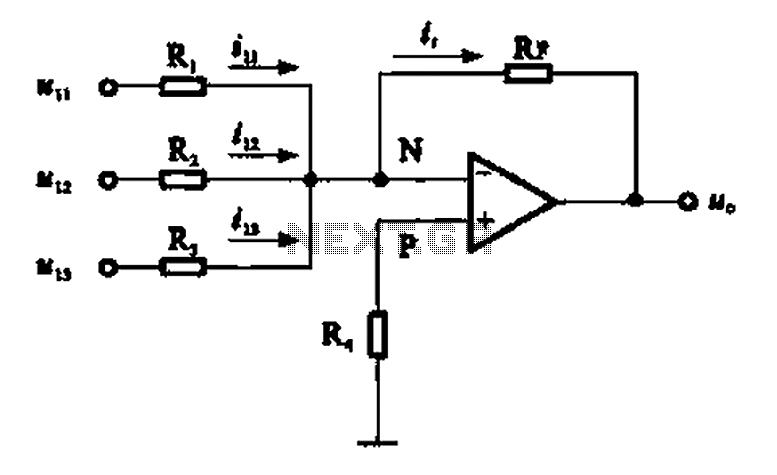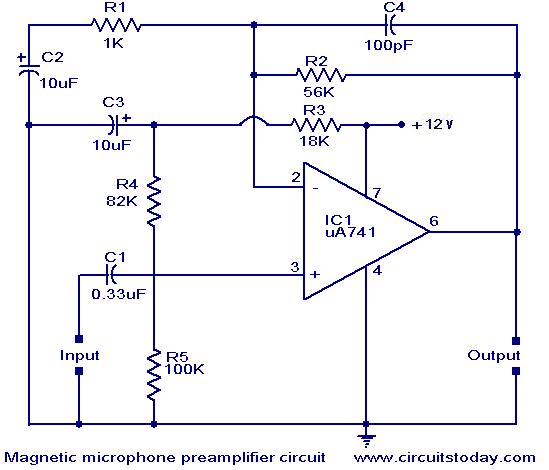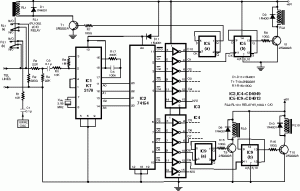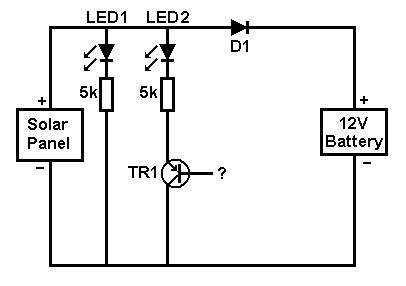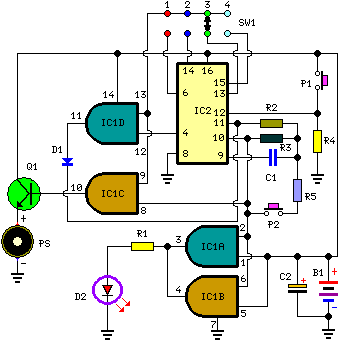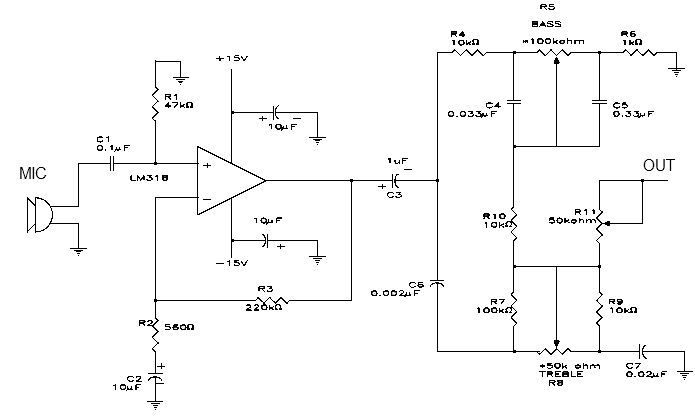
microphone computer circuit schematic
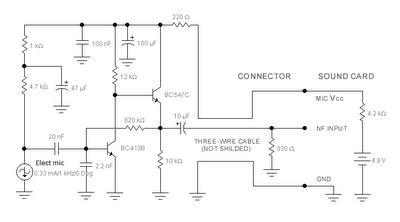
The sound card for a PC typically includes a microphone input, speaker output, and occasionally line inputs and outputs. The microphone input is specifically designed for dynamic microphones with an impedance range of 200 to 600 ohms. An adaptation has been made to the sound card to utilize a common electret microphone through a specific circuit design. This design features a composite amplifier constructed with two transistors. The BC413B transistor operates in a common emitter configuration to provide a slight boost to the microphone signal. This is followed by an emitter follower stage using the BC547C transistor. This configuration is essential because the microphone, circuit, and battery will be positioned at a distance from the sound card. The low output impedance of the circuit, combined with a screened cable, ensures a clean signal with minimal noise interference.
The described circuit for adapting an electret microphone to a PC sound card employs a two-stage amplifier configuration that enhances the microphone's output signal while maintaining signal integrity over distance. The first stage utilizes the BC413B transistor in a common emitter arrangement. This configuration is advantageous as it provides voltage gain, which is critical for boosting the low-level signal generated by the electret microphone. The choice of the BC413B is appropriate due to its suitable frequency response and gain characteristics, making it ideal for audio applications.
Following the initial amplification stage, the second stage employs a BC547C transistor configured as an emitter follower. This stage serves several purposes: it provides a high input impedance, which is beneficial for interfacing with the microphone, and a low output impedance, which is crucial for driving the cable to the sound card. The emitter follower configuration allows the circuit to buffer the amplified signal, ensuring that it can drive longer cable lengths without significant signal degradation or loss.
The overall design incorporates a power supply, typically a battery, which powers the electret microphone and the transistor stages. Careful consideration of the power supply voltage and current ratings is necessary to ensure the proper operation of the transistors and the microphone. Additionally, the use of a screened cable is essential to minimize electromagnetic interference (EMI) and radio frequency interference (RFI), which can introduce noise into the audio signal.
In summary, this circuit design effectively adapts an electret microphone for use with a PC sound card by employing a composite amplifier configuration that enhances signal quality and maintains integrity over distance, ensuring a reliable and clear audio input for various applications.The sound card for a PC generally has a microphone input, speaker output and sometimes line inputs and outputs. The mic input is designed for dynamic microphones only in impedance range of 200 to 600 ohms. Lazar has adapted the sound card to use a common electret microphone using this circuit. He has made a composite amplifier using two transistor s. Transistor BC413B operates in common emitter to give a slight boost to the mic signal. This is followed by an emitter follower stage using transistor BC547C. This is necessary as the mic and circuit and battery will be some distance from the sound card, the low output impedance of the circuit and screened cable ensuring a clean signal with minimum noise pickup. 🔗 External reference
The described circuit for adapting an electret microphone to a PC sound card employs a two-stage amplifier configuration that enhances the microphone's output signal while maintaining signal integrity over distance. The first stage utilizes the BC413B transistor in a common emitter arrangement. This configuration is advantageous as it provides voltage gain, which is critical for boosting the low-level signal generated by the electret microphone. The choice of the BC413B is appropriate due to its suitable frequency response and gain characteristics, making it ideal for audio applications.
Following the initial amplification stage, the second stage employs a BC547C transistor configured as an emitter follower. This stage serves several purposes: it provides a high input impedance, which is beneficial for interfacing with the microphone, and a low output impedance, which is crucial for driving the cable to the sound card. The emitter follower configuration allows the circuit to buffer the amplified signal, ensuring that it can drive longer cable lengths without significant signal degradation or loss.
The overall design incorporates a power supply, typically a battery, which powers the electret microphone and the transistor stages. Careful consideration of the power supply voltage and current ratings is necessary to ensure the proper operation of the transistors and the microphone. Additionally, the use of a screened cable is essential to minimize electromagnetic interference (EMI) and radio frequency interference (RFI), which can introduce noise into the audio signal.
In summary, this circuit design effectively adapts an electret microphone for use with a PC sound card by employing a composite amplifier configuration that enhances signal quality and maintains integrity over distance, ensuring a reliable and clear audio input for various applications.The sound card for a PC generally has a microphone input, speaker output and sometimes line inputs and outputs. The mic input is designed for dynamic microphones only in impedance range of 200 to 600 ohms. Lazar has adapted the sound card to use a common electret microphone using this circuit. He has made a composite amplifier using two transistor s. Transistor BC413B operates in common emitter to give a slight boost to the mic signal. This is followed by an emitter follower stage using transistor BC547C. This is necessary as the mic and circuit and battery will be some distance from the sound card, the low output impedance of the circuit and screened cable ensuring a clean signal with minimum noise pickup. 🔗 External reference
